Chemically Grafting Carbon Nanotubes onto Carbon Fibers for Enhancing Interfacial Properties of Fiber Metal Laminate
Abstract
1. Introduction
2. Experimental
2.1. Materials
2.2. Fabrication of Oxidized Carbon Fiber Weaves
2.3. Chemical Grafting of CNTs
2.4. Lap Joint Test Preparation
2.5. Characterization
3. Results and Discussion
3.1. Surface Chemistry Characteristics of Carbon Fiber
3.2. Surface Morphology of Carbon Fiber
3.3. Lap Joint Testing
3.4. Analysis of Micro-Morphology
4. Conclusions
Author Contributions
Funding
Acknowledgments
Conflicts of Interest
References
- Fu, Y.; Zhong, J.; Chen, Y. Thermal postbuckling analysis of fiber-metal laminated plates including interfacial damage. Compos. Part B Eng. 2014, 56, 358–364. [Google Scholar] [CrossRef]
- Sadighi, M.; Alderliesten, R.C.; Benedictus, R. Impact resistance of fiber-metal laminates: A review. Int. J. Impact Eng. 2012, 49, 77–90. [Google Scholar] [CrossRef]
- Moussavi-Torshizi, S.E.; Dariushi, S.; Sadighi, M.; Safarpour, P. A study on tensile properties of a novel fiber/metal laminates. Mater. Sci. Eng. A 2010, 527, 4920–4925. [Google Scholar] [CrossRef]
- Sinmazçelik, T.; Avcu, E.; Bora, M.Ö.; Çoban, O. A review: Fibre metal laminates, background, bonding types and applied test methods. Mater. Des. 2011, 32, 3671–3685. [Google Scholar] [CrossRef]
- Asundi, A.; Choi, A.Y.N. Fiber metal laminates: An advanced material for future aircraft. J. Mater. Process. Technol. 1997, 63, 384–394. [Google Scholar] [CrossRef]
- Xue, J.; Wang, W.X.; Takao, Y.; Matsubara, T. Reduction of thermal residual stress in carbon fiber aluminum laminates using a thermal expansion clamp. Compos. Part A Appl. Sci. Manuf. 2011, 42, 986–992. [Google Scholar] [CrossRef]
- Mehr, M.E.; Aghamohammadi, H.; Abbandanak, S.N.H.; Aghamirzadeh, G.R.; Eslami-farsani, R.; Siadati, S.M.H. Effects of applying a combination of surface treatments on the mechanical behavior of basalt fi ber metal laminates. Int. J. Adhes. Adhes. 2019, 92, 133–141. [Google Scholar] [CrossRef]
- Mertens, T.; Kollek, H. On the stability and composition of oxide layers on pre-treated titanium. Int. J. Adhes. Adhes. 2010, 30, 466–477. [Google Scholar] [CrossRef]
- Boon, Y.D.; Joshi, S.C.; Ong, L.S. Effects of Mechanical Surface Treatment on Bonding between Aluminum and Carbon/Epoxy Composites. Procedia Eng. 2017, 184, 552–559. [Google Scholar] [CrossRef]
- Akram, M.; Jansen, K.M.B.; Ernst, L.J.; Bhowmik, S. Atmospheric pressure plasma surface modification of titanium for high temperature adhesive bonding. Int. J. Adhes. Adhes. 2011, 31, 598–604. [Google Scholar] [CrossRef][Green Version]
- Aghamohammadi, H.; Abbandanak, S.N.H.; Eslami-farsani, R.; Siadati, S.M.H. Effects of various aluminum surface treatments on the basalt fi ber metal laminates interlaminar adhesion. Int. J. Adhes. Adhes. 2018, 84, 184–193. [Google Scholar] [CrossRef]
- Meng, L.; Fan, D.; Zhang, C.; Jiang, Z.; Huang, Y. Surface amination and hydrolyzation of carbon fibers treated with triethylene tetramine in supercritical water/ethanol system. Compos. Part B Eng. 2014, 56, 575–581. [Google Scholar] [CrossRef]
- Bj, A.; Lapique, F.; Walmsley, J.; Redford, K. Anodising as pre-treatment for structural bonding. Int. J. Adhes. Adhes. 2007, 23, 401–412. [Google Scholar]
- Soltannia, B.; Taheri, F. Influence of nano-reinforcement on the mechanical behavior of adhesively bonded single- lap joints subjected to static, quasi-static, and impact loading. J. Adhes. Sci. Technol. 2015, 29, 424–442. [Google Scholar] [CrossRef]
- Wang, C.; Chen, L.; Li, J.; Sun, S.; Ma, L.; Wu, G.; Zhao, F.; Jiang, B.; Huang, Y. Enhancing the interfacial strength of carbon fiber reinforced epoxy composites by green grafting of poly(oxypropylene) diamines. Compos. Part A Appl. Sci. Manuf. 2017, 99, 58–64. [Google Scholar] [CrossRef]
- Xu, Y.; Li, H.; Yang, Y.; Hu, Y.; Tao, J. Determination of residual stresses in Ti/CFRP laminates after preparation using multiple methods. Compos. Struct. 2019, 210, 715–723. [Google Scholar] [CrossRef]
- Gao, B.; Zhang, R.; Wang, C. Enhanced mechanical properties of carbon fiber composites by grafting different structural poly(amido amine) onto fiber surface. Polym. Test. 2016, 56, 192–199. [Google Scholar] [CrossRef]
- Schaefer, J.D.; Guzman, M.E.; Lim, C.S.; Rodriguez, A.J.; Minaie, B. Influence of functionalized carbon nanofibers on the single carbon fiber-epoxy matrix interface. Compos. Part B Eng. 2013, 55, 41–47. [Google Scholar] [CrossRef]
- Boccaccini, A.R.; Cho, J.; Roether, J.A.; Thomas, B.J.C.; Minay, E.J.; Shaffer, M.S.P. Electrophoretic deposition of carbon nanotubes. Carbon 2006, 44, 3149–3160. [Google Scholar] [CrossRef]
- Murugesan, S.; Myers, K.; Subramanian, V.R. Amino-functionalized and acid treated multi-walled carbon nanotubes as supports for electrochemical oxidation of formic acid. Appl. Catal. B Environ. 2011, 103, 266–274. [Google Scholar] [CrossRef]
- Xu, Z.; Huang, Y.; Zhang, C.; Liu, L.; Zhang, Y.; Wang, L. Effect of γ-ray irradiation grafting on the carbon fibers and interfacial adhesion of epoxy composites. Compos. Sci. Technol. 2007, 67, 3261–3270. [Google Scholar] [CrossRef]
- Ehlert, G.J.; Galan, U.; Sodano, H.A. Role of surface chemistry in adhesion between ZnO nanowires and carbon fibers in hybrid composites. ACS Appl. Mater. Interfaces 2013, 5, 635–645. [Google Scholar] [CrossRef] [PubMed]
- Peng, Q.; He, X.; Li, Y.; Wang, C.; Wang, R.; Hu, P.; Yan, Y.; Sritharan, T. Chemically and uniformly grafting carbon nanotubes onto carbon fibers by poly(amidoamine) for enhancing interfacial strength in carbon fiber composites. J. Mater. Chem. 2012, 22, 5928–5931. [Google Scholar] [CrossRef]
- Zhang, X.; Wu, G. Grafting Halloysite Nanotubes with Amino or Carboxyl Groups onto Carbon Fiber Surface for Excellent Interfacial Properties of Silicone Resin Composites. Polymers 2018, 10, 1171. [Google Scholar] [CrossRef] [PubMed]
- Peng, Q.; Li, Y.; He, X.; Lv, H.; Hu, P.; Shang, Y.; Wang, C.; Wang, R.; Sritharan, T.; Du, S. Interfacial enhancement of carbon fiber composites by poly(amido amine) functionalization. Compos. Sci. Technol. 2013, 74, 37–42. [Google Scholar] [CrossRef]
- Wu, G.; Ma, L.; Jiang, H.; Liu, L.; Huang, Y. Improving the interfacial strength of silicone resin composites by chemically grafting silica nanoparticles on carbon fiber. Compos. Sci. Technol. 2017, 153, 160–167. [Google Scholar] [CrossRef]
- Zhao, F.; Huang, Y. Improved interfacial properties of carbon fiber/epoxy composites through grafting polyhedral oligomeric silsesquioxane on carbon fiber surface. Mater. Lett. 2010, 64, 2742–2744. [Google Scholar] [CrossRef]
- Faggiani, A.; Falzon, B.G. Predicting low-velocity impact damage on a stiffened composite panel. Compos. Part A Appl. Sci. Manuf. 2010, 41, 737–749. [Google Scholar] [CrossRef]
- Zhao, M.; Meng, L.; Ma, L.; Ma, L.; Yang, X.; Huang, Y.; Ryu, J.E.; Shankar, A.; Li, T.; Yan, C.; et al. Layer-by-layer grafting CNTs onto carbon fibers surface for enhancing the interfacial properties of epoxy resin composites. Compos. Sci. Technol. 2018, 154, 28–36. [Google Scholar] [CrossRef]
- Yao, H.; Sui, X.; Zhao, Z.; Xu, Z.; Chen, L.; Deng, H.; Liu, Y. Applied Surface Science Optimization of interfacial microstructure and mechanical properties of carbon fiber/epoxy composites via carbon nanotube sizing. Appl. Surf. Sci. 2015, 347, 583–590. [Google Scholar] [CrossRef]
- Liu, Y.; Wu, G.; Lu, C. Grafting of carbon nanotubes onto carbon fi ber surfaces by step-wise reduction of in-situ generated diazonium salts for enhancing carbon/epoxy interfaces. Mater. Lett. 2014, 134, 75–79. [Google Scholar] [CrossRef]
- Zhao, M.; Meng, L.; Ma, L.; Wu, G.; Wang, Y.; Xie, F.; Huang, Y. Interfacially reinforced carbon fiber/epoxy composites by grafting melamine onto carbon fibers in supercritical methanol. RSC Adv. 2016, 6, 29654–29662. [Google Scholar] [CrossRef]
- Yao, X.; Gao, X.; Jiang, J.; Xu, C.; Deng, C.; Wang, J. Comparison of carbon nanotubes and graphene oxide coated carbon fiber for improving the interfacial properties of carbon fiber/epoxy composites. Compos. Part B Eng. 2018, 132, 170–177. [Google Scholar] [CrossRef]
- Wang, Y.; Kumar, S.; Pillai, R.; Che, J.; Chan-park, M.B. Supporting Information High Interlaminar Shear Strength Enhancement of Carbon Fiber/Epoxy Composite through Fiber- and Matrix-Anchored Carbon Nanotube Networks. ACS Appl. Mater. Interfaces 2017, 9, 8960–8966. [Google Scholar] [CrossRef]
- Cha, J.; Jun, G.H.; Park, J.K.; Kim, J.C.; Ryu, H.J.; Soon, H.H. Improvement of modulus, strength and fracture toughness of CNT/Epoxy nanocomposites through the functionalization of carbon nanotubes. Compos. Part B Eng. 2017, 129, 169–179. [Google Scholar] [CrossRef]
- Ehlert, G.J.; Lin, Y.; Sodano, H.A. Carboxyl functionalization of carbon fibers through a grafting reaction that preserves fiber tensile strength. Carbon 2011, 49, 4246–4255. [Google Scholar] [CrossRef]
- Khurram, A.A.; Hussain, R.; Afzal, H.; Akram, A.; Subhanni, T. International Journal of Adhesion and Adhesives Carbon nanotubes for enhanced interface of fi ber metal laminate. Int. J. Adhes. Adhes. 2018, 86, 29–34. [Google Scholar] [CrossRef]
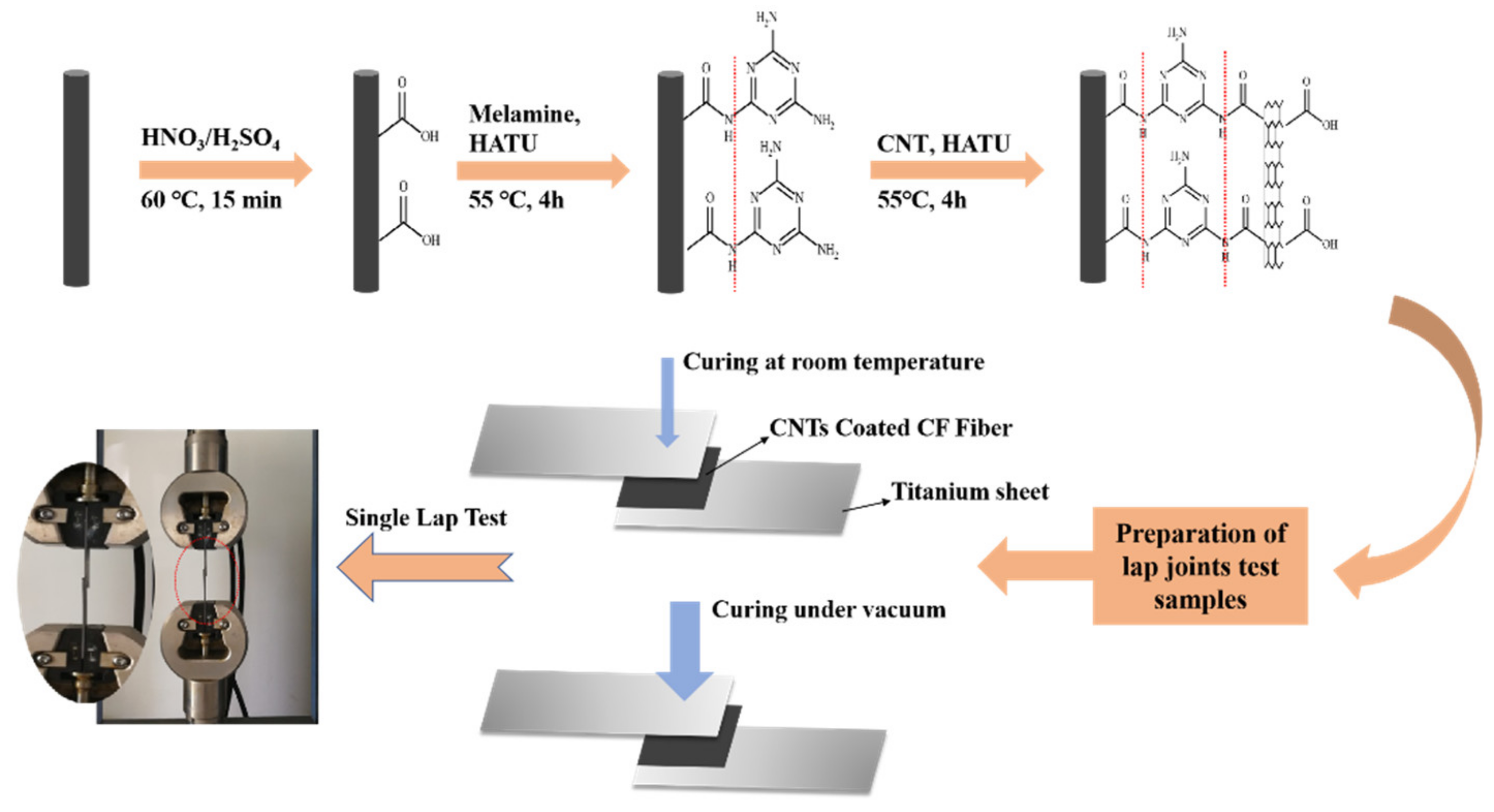
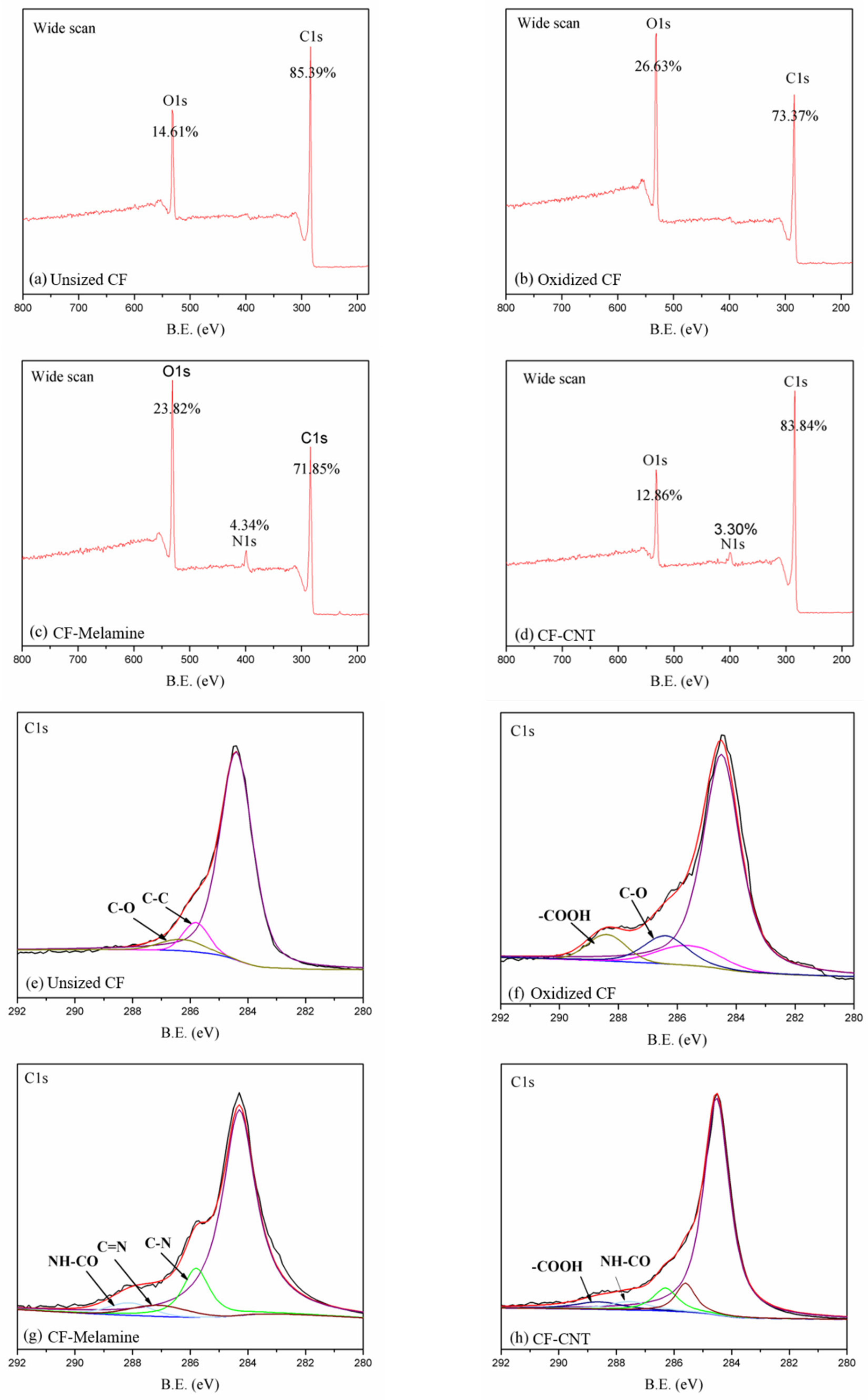
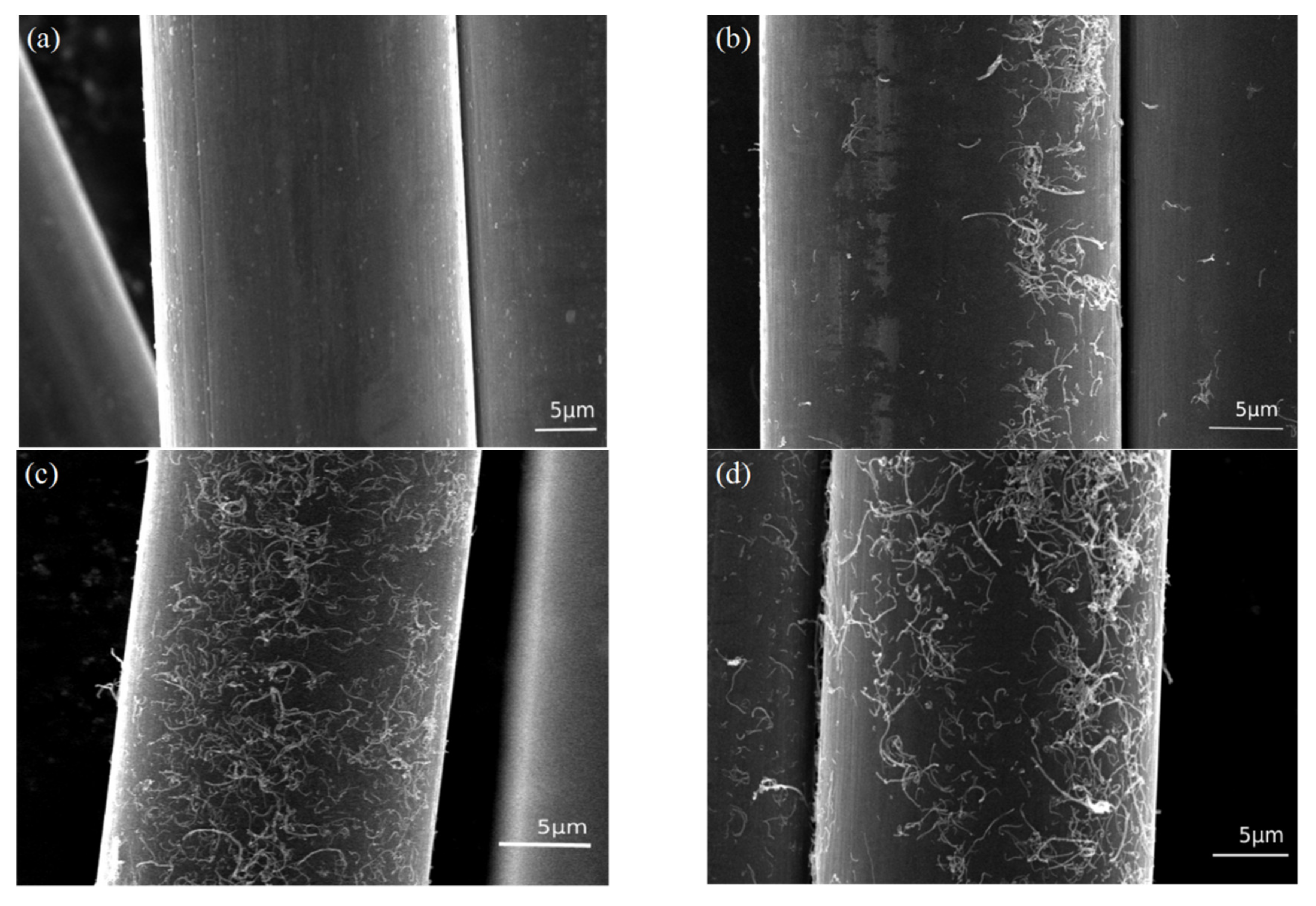
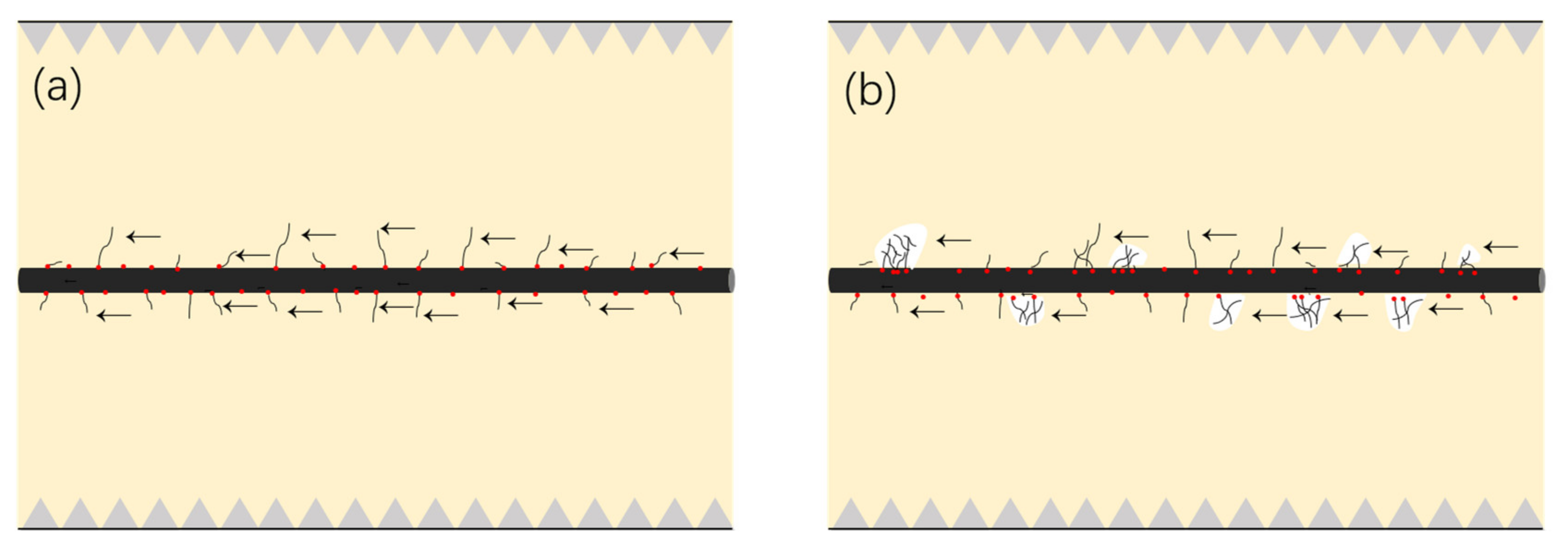
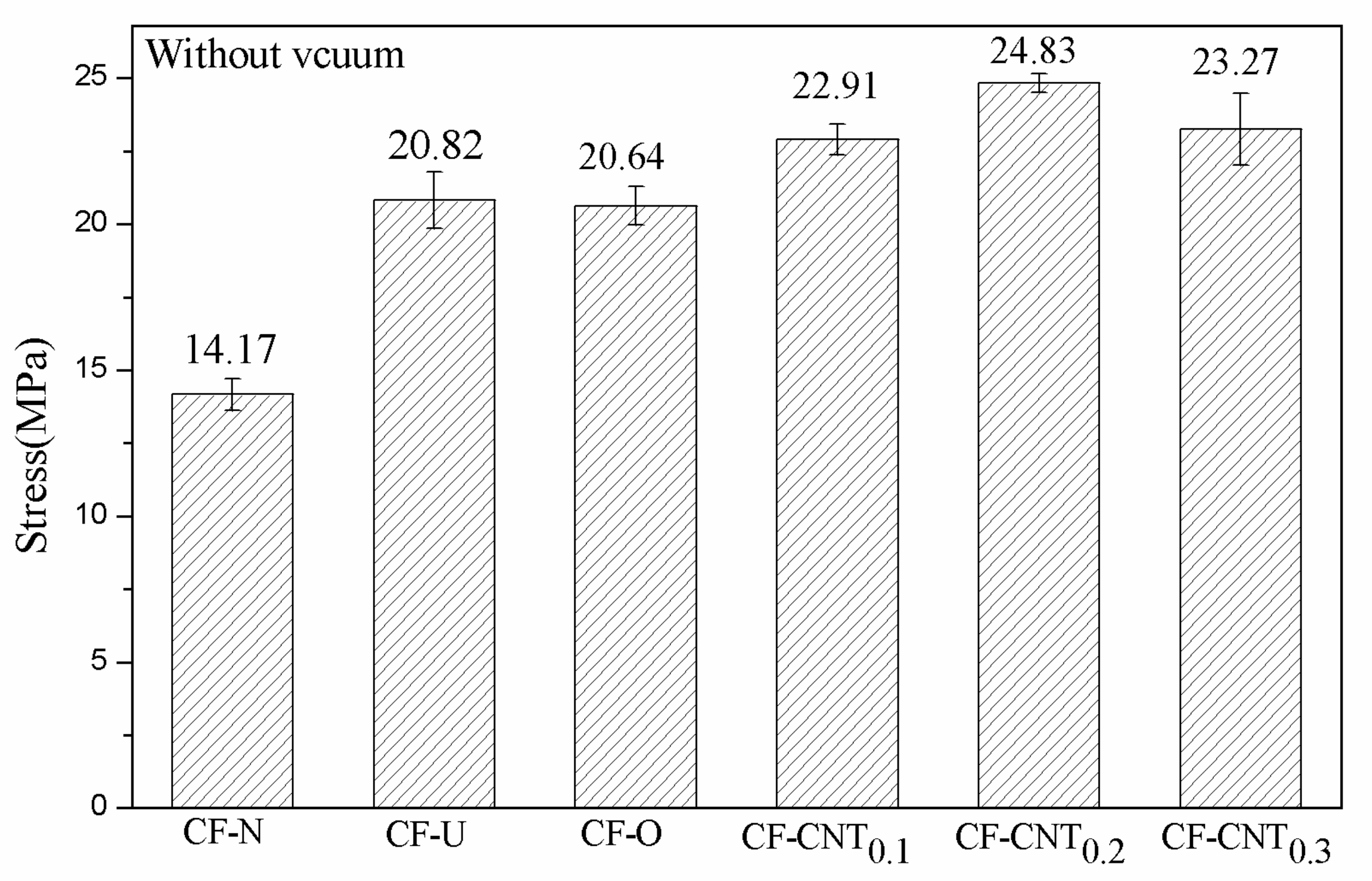
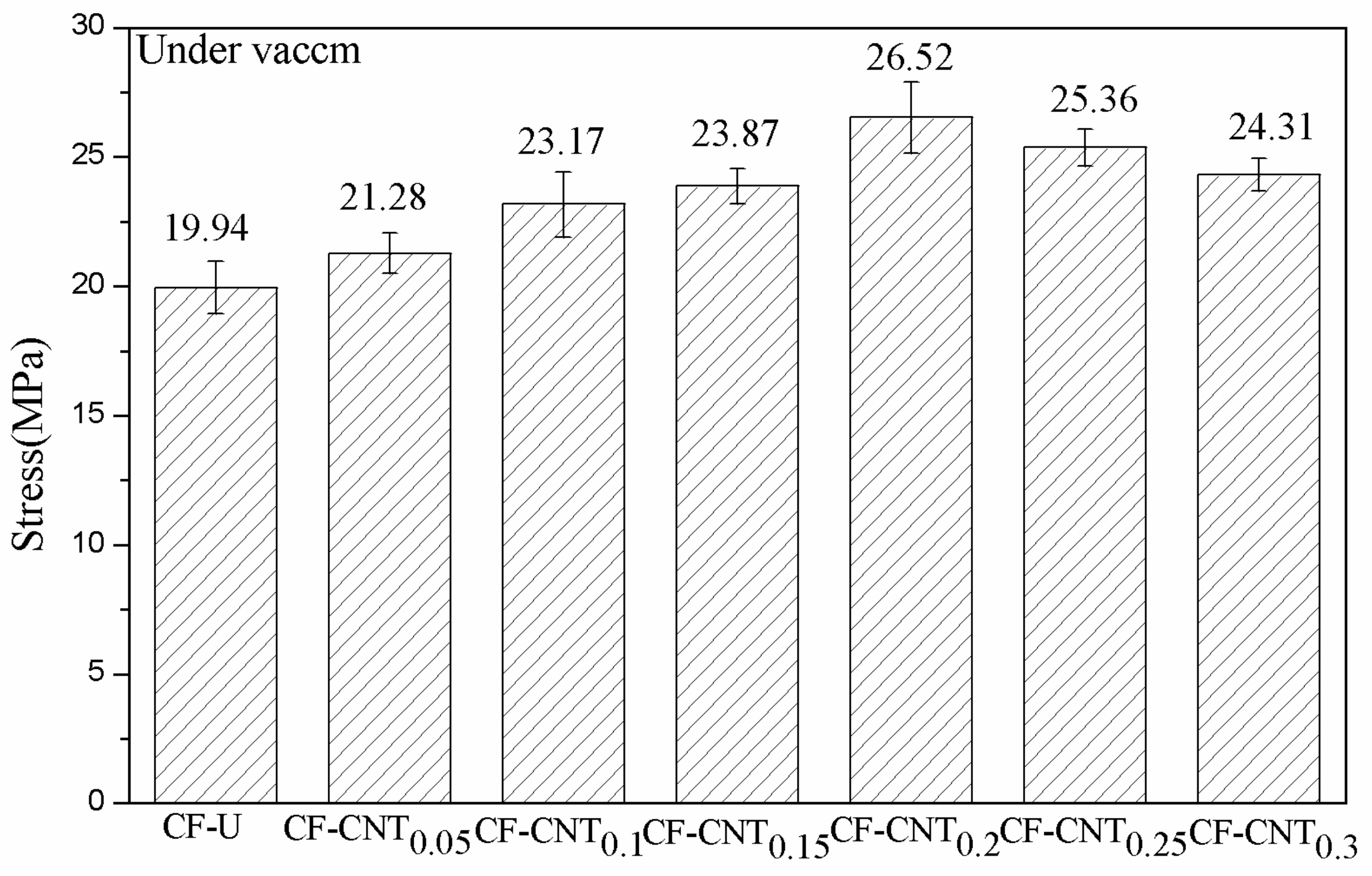
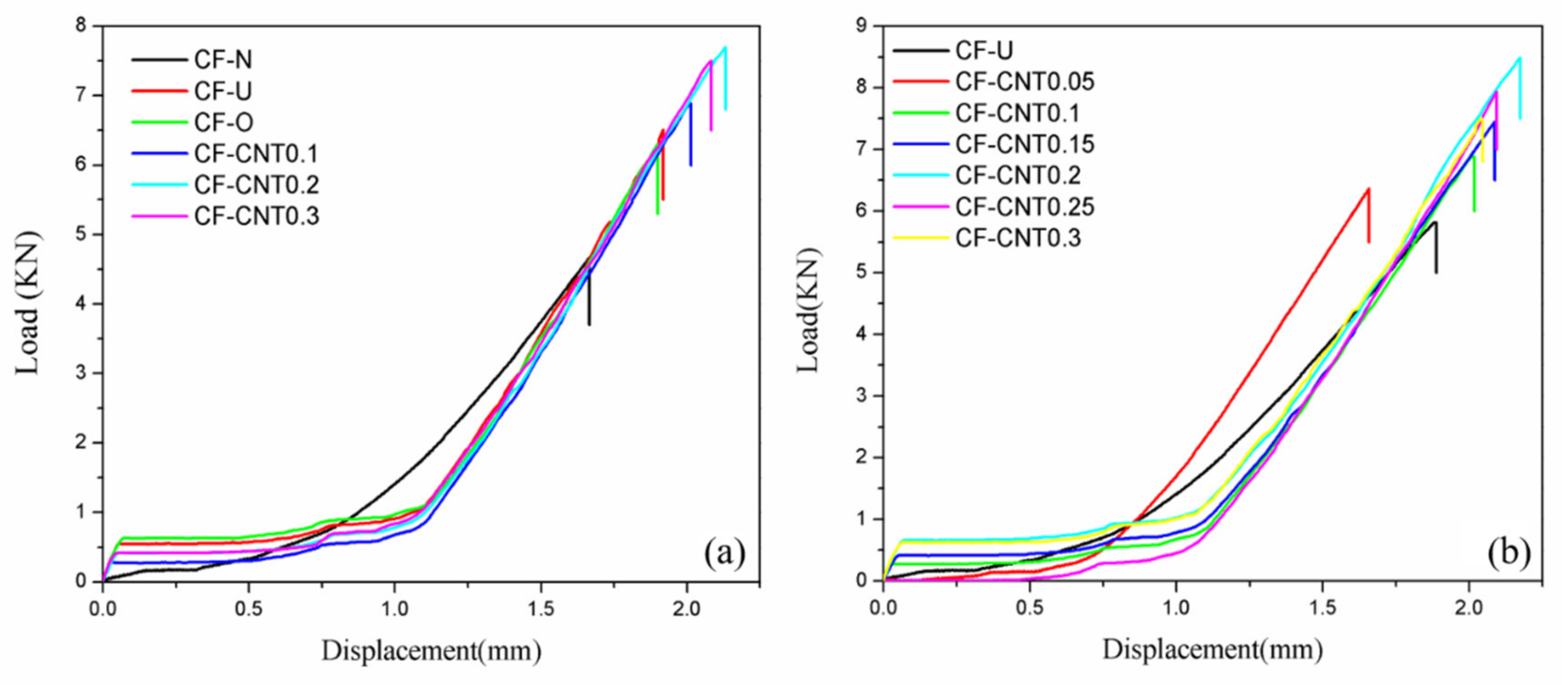
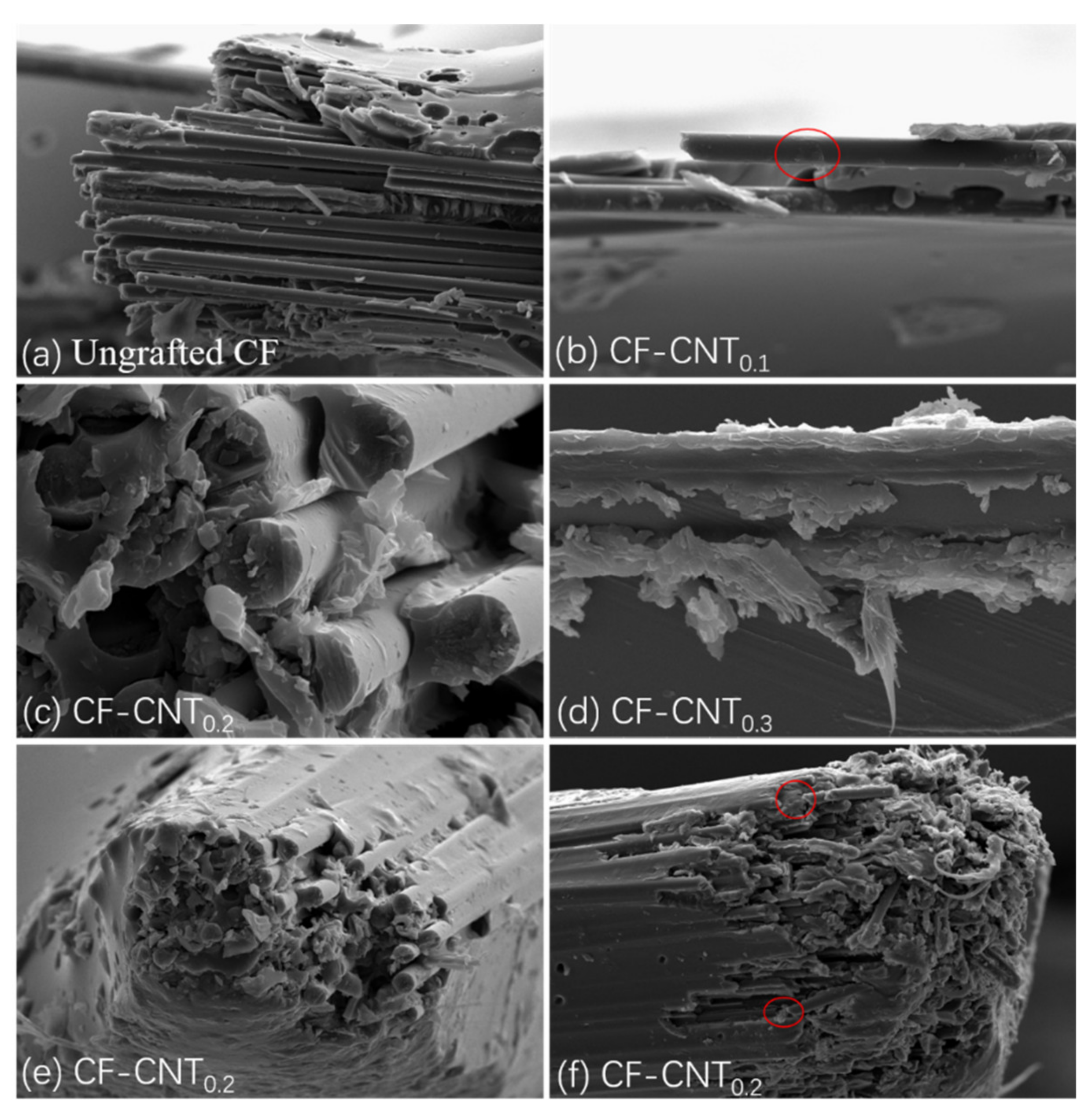
| Sample Code | Variously Treated Carbon Fiber Weaves |
|---|---|
| CF-N | No carbon fiber weaves added |
| CF-D | Unsized carbon fiber weaves |
| CF-O | Oxidized carbon fiber weaves |
| CF-CNT0.05 | Grafted carbon fiber weaves with CNT concentration of 0.05 mg/mL |
| CF-CNT0.1 | Grafted carbon fiber weaves with CNT concentration of 0.1 mg/mL |
| CF-CNT0.15 | Grafted carbon fiber weaves with CNT concentration of 0.15 mg/mL |
| CF-CNT0.2 | Grafted carbon fiber weaves with CNT concentration of 0.2 mg/mL |
| CF-CNT0.25 | Grafted carbon fiber weaves with CNT concentration of 0.25 mg/mL |
| CF-CNT0.3 | Grafted carbon fiber weaves with CNT concentration of 0.3 mg/mL |
| Sample | C | O | N |
|---|---|---|---|
| unsized CF | 85.39% | 14.61% | 0 |
| oxidized CF | 73.37% | 26.63% | 0 |
| CF-Melamine | 71.85% | 23.82% | 4.34% |
| CF- CNT | 83.84% | 12.86% | 3.30% |
| Sample Code | Stress (MPa) | SD | Increase (%) |
|---|---|---|---|
| CF-N | 14.17 | 0.54 | - |
| CF-U | 20.82 | 0.96 | 46.93 |
| CF-O | 20.64 | 0.65 | 45.66 |
| CF-CNT0.1 | 22.91 | 0.53 | 61.68 |
| CF-CNT0.2 | 24.83 | 0.32 | 75.23 |
| CF-CNT0.3 | 23.27 | 1.23 | 64.22 |
| Sample Code | Stress (MPa) | SD | Increase (%) |
|---|---|---|---|
| CF-U | 19.94 | 1.01 | 40.72 |
| CF-CNT0.05 | 21.28 | 0.78 | 50.18 |
| CF-CNT0.1 | 23.17 | 1.26 | 63.51 |
| CF-CNT0.15 | 23.87 | 0.69 | 68.45 |
| CF-CNT0.2 | 26.52 | 1.38 | 87.16 |
| CF-CNT0.25 | 25.36 | 0.72 | 78.96 |
| CF-CNT0.3 | 24.31 | 0.63 | 71.56 |
© 2020 by the authors. Licensee MDPI, Basel, Switzerland. This article is an open access article distributed under the terms and conditions of the Creative Commons Attribution (CC BY) license (http://creativecommons.org/licenses/by/4.0/).
Share and Cite
Ji, F.; Liu, C.; Hu, Y.; Xu, S.; He, Y.; Zhou, J.; Zhang, Y. Chemically Grafting Carbon Nanotubes onto Carbon Fibers for Enhancing Interfacial Properties of Fiber Metal Laminate. Materials 2020, 13, 3813. https://doi.org/10.3390/ma13173813
Ji F, Liu C, Hu Y, Xu S, He Y, Zhou J, Zhang Y. Chemically Grafting Carbon Nanotubes onto Carbon Fibers for Enhancing Interfacial Properties of Fiber Metal Laminate. Materials. 2020; 13(17):3813. https://doi.org/10.3390/ma13173813
Chicago/Turabian StyleJi, Fan, Cheng Liu, Yubing Hu, Shengnan Xu, Yiyan He, Jin Zhou, and Yanan Zhang. 2020. "Chemically Grafting Carbon Nanotubes onto Carbon Fibers for Enhancing Interfacial Properties of Fiber Metal Laminate" Materials 13, no. 17: 3813. https://doi.org/10.3390/ma13173813
APA StyleJi, F., Liu, C., Hu, Y., Xu, S., He, Y., Zhou, J., & Zhang, Y. (2020). Chemically Grafting Carbon Nanotubes onto Carbon Fibers for Enhancing Interfacial Properties of Fiber Metal Laminate. Materials, 13(17), 3813. https://doi.org/10.3390/ma13173813






